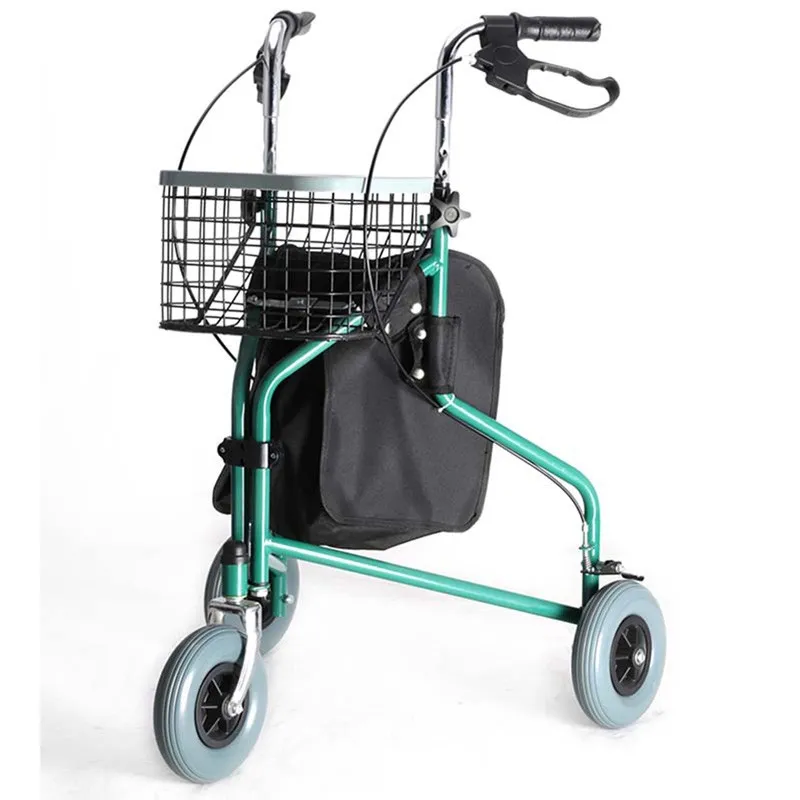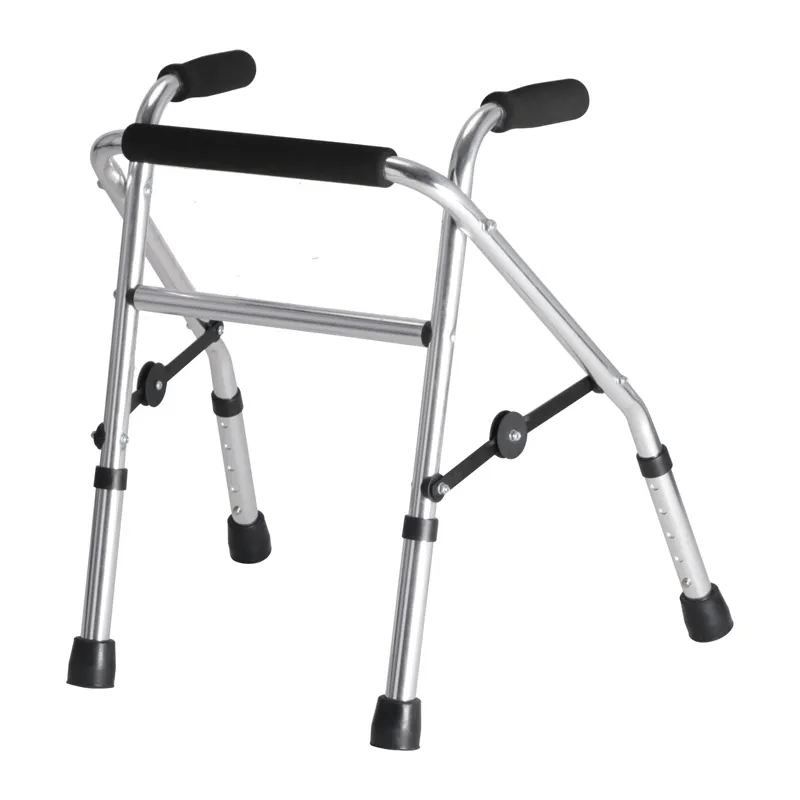With an aging population and a growing number of people recovering from chronic diseases, 4-wheeled rollator walkers have become a common mobility aid for community rehabilitation, outpatient follow-up, and home life.
This article systematically addresses common questions such as "What is a 4-wheeled rollator?", "What is the structure and working principle of a 4-wheeled rollator?", and "Who is suitable for a 4-wheeled rollator?", helping patients, families, and frontline medical personnel make informed choices.
What Is A 4-Wheeled Rollator Walker?
A 4-wheeled rollator generally refers to a "rolling walker" with four wheels, an adjustable handle, a handbrake, and, often, a seat with a backrest and a storage basket. Unlike traditional wheelless walking frames, a 4-wheeled rollator glides on wheels; the user pushes the device forward and uses the handbrake to slow or stop when needed.
Rodders come in both three-wheel and four-wheel versions. Four-wheeled rollators are commonly used for long-distance outdoor mobility or when resting during travel due to their larger contact surface area, better load-bearing capacity, and generally better stability.
The basic structure of a 4-wheeled rollator includes:
An aluminum or steel frame, four steerable wheels, a height-adjustable handlebar, brakes on the handlebars (mostly lockable), a seat or cushion, an underseat storage basket or bag, and a mechanism for folding and storing.
Various models may also feature accessories such as larger wheels (for uneven surfaces), a removable backrest, oxygen tank clips, cup holders, and crutch/rain gear holders. High-end models typically emphasize lightweight, foldable portability, and ergonomic brakes.

3 wheel rollator

4 wheel rollator

wheelless walking frame
What Is the Purpose of A 4-Wheeled Rollator?
The core design principle of a 4-wheeled rollator is to reduce energy consumption during walking through wheeled gliding, while also providing a seat and handbrake control when needed. It is neither a full-weight support nor a simple crutch: it is targeted at users who require balance support and endurance assistance while still being able to stand and walk independently. With larger wheels and a handbrake, 4-wheeled rollator walkers offer smoother mobility in relatively complex outdoor environments (such as short gravel, small steps, and slopes).
Why Are 4-Wheeled Rollator Walkers Increasingly Popular?
Advantages of 4-Wheeled Rollator Walkers:
1. Effort-saving and relatively faster
2. Built-in seat for easy rest
3. Versatile accessories for convenient use
4. High adaptability to complex terrain
• Effort-saving and relatively faster: The push-type design allows users to walk at a pace close to their natural gait, making it ideal for strolling, shopping, or community activities.
• Built-in seat for easy rest: 4-wheeled rollator walkers typically come with a built-in seat, allowing users to sit down when tired, reducing the risk of falls caused by prolonged standing or walking.
• Versatile accessories for convenient use: Baskets, backpacks, cup holders, and other accessories make carrying items convenient, making it easy to carry items when shopping or carrying oxygen tanks.
• High adaptability to complex terrain: The large wheel diameter and steerable front wheel enhance off-road suitability (such as sidewalks and outdoor park paths).
These advantages make the 4-wheeled rollator walker a frequently recommended device in senior living communities, rehabilitation clinics, and even for daily mobility assistance.
Disadvantages of 4-Wheeled Rollator Walkers:
1. Not suitable for those who need to bear weight or are completely dependent on support.
2. Risk of sliding due to brake misapplication or failure to lock the device promptly.
3. Limitations on stairs and narrow corridors.
4. Caution is advised for use by those with cognitive impairments.
• Not suitable for those who need to bear weight or are completely dependent on support: If the user needs to place a significant amount of weight on the walker (e.g., severe lower limb weakness, or strict partial weight-bearing restrictions in the early postoperative period), the 4-wheeled rollator walker is not the preferred choice due to its "wheel-rolling" nature. Traditional wheelless walkers or side-by-side walkers may be more secure.
• Risk of sliding due to brake misapplication or failure to lock the device promptly: If the user is unfamiliar with the handbrake, fails to use the parking function correctly, or releases the handbrake on a slope, the walker may slide out of control. Such accidents are not uncommon in the absence of proper training.
• Stair and Narrow Passageway Limitations: 4-wheeled rollator walkers are not suitable for ascending and descending stairs alone, and may not be maneuverable in confined indoor spaces (such as small bathrooms and narrow hallways).
• Caution is advised when using a 4-wheeled rollator walker: Individuals with cognitive impairment or impaired judgment may not brake promptly or sit down properly when needed, increasing the risk of falls. Clinically, it is often recommended to conduct an assessment before deciding whether to use a 4-wheeled rollator walker.
Thus, while 4-wheeled rollator walkers offer significant convenience, their safety and effectiveness are closely related to proper fit and training.

Who Is A 4-Wheeled Rollator Walker Suitable For?
In clinical and rehabilitation settings, the following categories are often used to determine who is suitable for a 4-wheeled rollator walker. The key principle is that individuals who can stand on their own, have adequate upper limb control, and require assistance with balance and endurance are more suitable for 4-wheeled rollator walkers.
4 Wheeled Rollator Walker is Suitable For People:
1. Individuals with mild to moderate balance impairment who can walk independently
2. Elderly individuals with reduced endurance who need to travel long distances or frequently go out
3. Individuals prone to fatigue due to respiratory or cardiovascular diseases (such as chronic obstructive pulmonary disease)
4. Patients undergoing intermediate-term rehabilitation after chronic arthritis (OA) or hip/knee replacement surgery
5. Elderly individuals living alone in the community (but with good cognitive function)
1. Individuals with mild to moderate balance impairment who can walk independently
These individuals require additional balance assistance but do not rely on full weight bearing. A 4-wheeled rollator walker provides stable gliding support and a comfortable seat for resting at any time.
2. Elderly individuals with reduced endurance who need to travel long distances or frequently go out
For those who need to go shopping, walking, or participate in community activities on a daily basis, a 4-wheeled rollator walker can reduce fatigue and increase independence.
3. Individuals prone to fatigue due to respiratory or cardiovascular conditions (such as chronic obstructive pulmonary disease)
Because a 4-wheeled rollator allows for rest breaks and oxygen delivery during activities, it is often recommended after professional evaluation.
4. Patients recovering from chronic arthritis (OA) or hip/knee replacement surgery
In the early postoperative period, weight-bearing restrictions or the use of a more stable wheelless walker are often necessary. However, during the recovery phase, after a doctor approves weight-bearing, a 4-wheeled rollator can be used to extend time outdoors and increase independence. The choice should be evaluated jointly by the attending physician and a physical therapist.
5. Elderly individuals living alone in the community (with good cognitive function)
For elderly individuals living alone who have daily needs and can master the braking and sitting movements, a 4-wheeled rollator can significantly improve their independence.
4-Wheeled Rollator Walker is Not Suitable For People:
People who are completely unable to stand independently, those who rely heavily on equipment for weight support, those with severe cognitive impairments who cannot be supervised, and those who need to navigate extremely narrow spaces and frequently ascend and descend stairs should avoid using a 4-wheeled rollator walker alone or seek professional advice on alternatives.
How to Use A 4-Wheeled Rollator Walker Correctly?
To reduce accidents and maximize its effectiveness, using a 4-wheeled rollator requires mastering the following key movements and habits:
1. Handle Height: When standing, hold the handlebars with your elbows naturally bent approximately 15–30 degrees (or with the top of the handle aligned with your wrist crease) to ensure your upper limbs are relaxed and easy to brake.
2. Learning to Use the Brakes: Practice applying the brakes firmly and locking the parking function on level ground to ensure reliable braking when sitting down or parking.
3. Sitting and Standing: Before sitting, park the rollator, engage the brakes, and then slowly turn around to sit. When standing up, release the brakes, hold onto the handlebars with both hands, and then stand firmly. Rehabilitation therapists should demonstrate and have users repeat the exercise.
4. Be mindful of slopes and steps: Avoid using a 4-wheeled rollator alone on steep slopes or stairs. When encountering low steps (curbsides), lean sideways, slow down, and seek a ramp or assistance if possible.
5. Folding and transportation: Master the correct folding technique and secure it securely in a vehicle trunk or on public transportation to prevent slipping injuries.
During rehabilitation training, it is generally recommended to practice first on safe surfaces such as flat ground and hallways, then gradually transition to more complex environments such as streets and parks.
(Video of the four-Wheeled Rollator Usage Process)
Walking Assistance Devices: When to Choose a 4-wheeled Rollator?
1. 4-Wheeled Rollator Vs. Wheelless Walking Frame
Wheelless walking frames offer greater static stability and are suitable for those who require significant weight transfer or have an extremely unstable gait. 4-wheeled rollators are suitable for those who require exercise efficiency and the ability to rest mid-walk. The choice should be based on whether the user can stand independently, whether they need to bear significant weight, and the walking environment.
2. 4-Wheeled Rollator Vs. Crutch
Crutches are suitable for mild balance assistance or unilateral support needs; 4-wheeled Rollator is suitable for users who require bilateral, continuous balance support and frequent rest breaks.
3. 4-Wheeled Rollator Vs. 3-wheeled Rollator
3-wheeled Rollator is more flexible and has a smaller turning radius, making it suitable for indoor use or confined spaces; 4-wheeled Rollator is more stable and has a stronger load-bearing capacity, making it better suited for outdoor use and on uneven surfaces.
What Types of Mobility Products Does Your Factory Produce?
Dayang Medical is a dedicated China manufacturer of premium mobility aids. Our range includes powered and manual wheelchairs, 4-wheeled Rollator, walker frames, bathroom safety items, and hospital beds. With a full-scale production base in Foshan, we deliver certified medical devices to buyers worldwide. We support bulk purchasing, OEM branding, and provide competitive quotes to help healthcare providers, retailers, and distributors find high-quality solutions at affordable prices.










